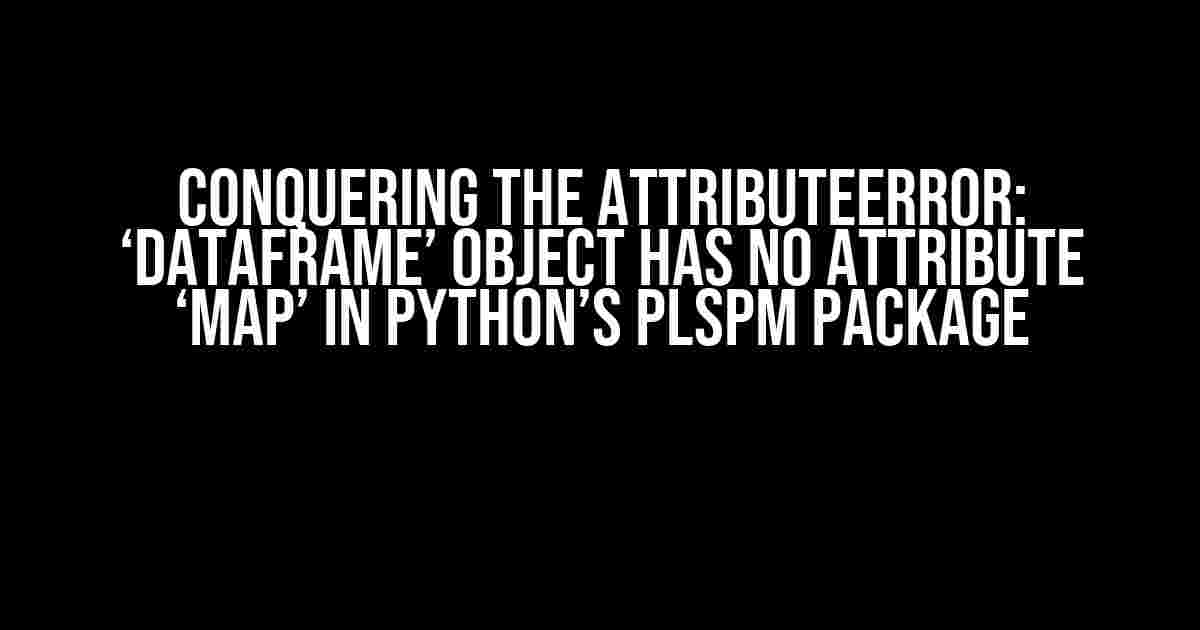If you’re reading this, chances are you’ve stumbled upon the frustrating error “AttributeError: ‘DataFrame’ object has no attribute ‘map'” while working with Python’s PLSPM package. Don’t worry, you’re not alone! This error can be a real showstopper, but fear not, dear reader, for we’re about to dive deep into the world of DataFrame manipulation and emerge victorious.
- What’s Causing the Error?
- Solution 1: Verify Pandas Installation and Importation
- Solution 2: Check DataFrame Creation and Reference
- Solution 3: Resolve Conflicts with Other Libraries or Functions
- Additional Troubleshooting Steps
- Real-World Example: Using the `map` Function with a DataFrame
- Conclusion
What’s Causing the Error?
Before we dive into the solutions, let’s take a step back and understand what’s causing this error. The `map` function is a part of the Pandas library, which is a fundamental component of the PLSPM package. It’s used to apply a function or a dictionary to a DataFrame column. However, when you encounter the “AttributeError: ‘DataFrame’ object has no attribute ‘map'” error, it indicates that the `map` function is not recognized as a valid method for the DataFrame object.
Potential Reasons for the Error
There are a few reasons why you might be encountering this error:
- The Pandas library is not properly installed or imported.
- The DataFrame object is not properly created or referenced.
- There’s a conflict with another library or function that’s using the `map` name.
Solution 1: Verify Pandas Installation and Importation
The first step in solving this error is to ensure that Pandas is properly installed and imported. Here’s how to do it:
import pandas as pd
print(pd.__version__)If you get an error or a version number, you’re good to go! If not, you might need to install Pandas using pip:
pip install pandasSolution 2: Check DataFrame Creation and Reference
Next, let’s take a closer look at how you’re creating and referencing your DataFrame. Here’s an example of a basic DataFrame creation:
import pandas as pd
data = {'Name': ['John', 'Mary', 'Bob'],
'Age': [25, 31, 42],
'Score': [85, 90, 78]}
df = pd.DataFrame(data)
print(df)Make sure that your DataFrame is properly created and referenced in your code. If you’re still encountering the error, try reinstalling Pandas or checking for any typos in your code.
Solution 3: Resolve Conflicts with Other Libraries or Functions
In some cases, another library or function might be using the `map` name, causing a conflict with the Pandas `map` function. To resolve this, you can try the following:
- Rename the conflicting function or variable.
- Use the fully qualified name of the Pandas `map` function: `pd.Series.map()`.
- Import the `map` function from Pandas explicitly: `from pandas import Series, DataFrame`.
Additional Troubleshooting Steps
If the above solutions don’t work, here are some additional steps to take:
- Check for any circular imports in your code.
- Verify that you’re using the correct version of Pandas and PLSPM.
- Try upgrading Pandas and PLSPM to the latest versions.
- Check for any typos or syntax errors in your code.
- Use a debugger or IDE to step through your code and identify the exact line causing the error.
Real-World Example: Using the `map` Function with a DataFrame
Let’s take a look at an example that demonstrates the correct usage of the `map` function with a DataFrame:
import pandas as pd
# Create a sample DataFrame
data = {'Name': ['John', 'Mary', 'Bob'],
'Age': [25, 31, 42],
'Score': [85, 90, 78]}
df = pd.DataFrame(data)
# Create a dictionary to map scores to grades
grades = {85: 'B', 90: 'A', 78: 'C'}
# Use the map function to apply the grades to the 'Score' column
df['Grade'] = df['Score'].map(grades)
print(df)This code creates a DataFrame with a ‘Score’ column, maps the scores to grades using a dictionary, and adds a new ‘Grade’ column to the DataFrame. Running this code should output the following result:
| Name | Age | Score | Grade |
|---|---|---|---|
| John | 25 | 85 | B |
| Mary | 31 | 90 | A |
| Bob | 42 | 78 | C |
Conclusion
There you have it, folks! With these solutions and troubleshooting steps, you should be able to overcome the “AttributeError: ‘DataFrame’ object has no attribute ‘map'” error and unlock the full potential of the PLSPM package. Remember to double-check your Pandas installation, DataFrame creation, and code syntax to ensure that you’re using the `map` function correctly. Happy coding!
Frequently Asked Question
Got stuck with the pesky “AttributeError: ‘DataFrame’ object has no attribute ‘map'” error while using the PLSPM package in Python? Don’t worry, we’ve got you covered! Here are some frequently asked questions and answers to help you troubleshoot and overcome this issue:
What is the ‘AttributeError: ‘DataFrame’ object has no attribute ‘map” error, and why does it occur?
This error occurs when the Python interpreter is unable to find the ‘map’ attribute in a DataFrame object. This is usually due to a version conflict or a missing package. The ‘map’ function is a part of the Pandas library, and if it’s not properly imported or if the package is outdated, you might encounter this error.
How can I check if I have the correct version of Pandas installed?
You can check the version of Pandas by running the following command in your Python environment: `import pandas as pd; print(pd.__version__)`. If you’re using an outdated version, you can update it by running `pip install –upgrade pandas`.
Is it possible that the ‘map’ function is not compatible with the PLSPM package?
Yes, it’s possible. The PLSPM package might have its own implementation of the ‘map’ function, which could be conflicting with the Pandas ‘map’ function. Try to import the ‘map’ function explicitly from the Pandas library using `from pandas.DataFrame import map` to see if it resolves the issue.
Can I use an alternative to the ‘map’ function to achieve the same result?
Yes, you can use the ‘apply’ function as an alternative to the ‘map’ function. For example, instead of using `df.map(function)`, you can use `df.apply(function)` to apply the function to each element in the DataFrame.
How can I debug the code to identify the root cause of the ‘AttributeError’?
To debug the code, you can try to isolate the line of code that’s throwing the error by adding print statements or using a Python debugger like pdb. You can also try to check the type of the DataFrame object by using the `type()` function to ensure it’s a Pandas DataFrame.


